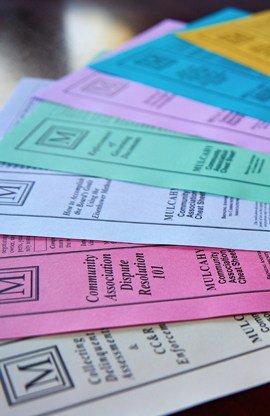Reserve Funds for Community Associations
Arizona law does not require a developer or an association to create and fund reserves for a community association (however, some association documents may require this). Adequate reserve funding is in the best financial interest of the association. Reserve funding allows an association to provide for the repair, maintenance, and replacement of the association’s assets as the community ages.
What is a Reserve Study?
The reserve study is a budgeting guide that will provide a comprehensive plan
that shows an association how much is reasonable to place in reserve for a specific replacement or maintenance project. When properly executed, it can give a clear picture of the maintenance, repair, or replacement requirements of association assets for the life of the association.
A reserve study starts with an accurate inventory of the community’s assets to
determine the useful life of said assets and a review of the association documents to determine the responsibilities of the association regarding property and assets.
A reserve study should provide:
- A detailed inventory of association assets that are labeled as assets for the reserve account;
- Location of the assets;
- Current age and remaining life of each asset creating a timeline for scheduled repair, maintenance, or replacement;
- The cost to replace each asset when necessary;
- The costs of repair or maintenance, ie. painting association fences; and
- A calculation of the monthly contribution required to have proper funding for
repair, maintenance, or replacement when needed.
Reasons for Establishing a Reserve Fund
Educated homebuyers may not invest in a community that is not maintained, has debt, or does not have an adequate reserve fund. Additionally, lenders may not approve mortgage applications in communities with no reserve or low reserves. Arizona does not require reserves or a reserve study, however, planned communities and condominiums in Arizona with fifty or more lots/units are required to disclose to purchasers the amount of money held in reserves and provide a copy of the most recent reserve study (if any) in a disclosure statement under A.R.S. Sections 33-1806, planned communities and A.R.S. Section 33-1260, condominiums.
- The following are common reasons for maintaining a reserve fund:
- Reserve funding meets legal, fiduciary, and professional requirements;
- A reserve fund provides for the planned replacement of major items;
- A reserve fund distributes the contributions of old and new owners;
- A reserve fund minimizes or negates the need for special assessments; and
A reserve fund enhances resale values because associations must disclose
information about their reserve funding policies.
How Does the Association Determine an Adequate Reserve Fund?
The reserve study inventory should determine assets that will be included in a reserve budget and also label those items that will be operational expenses.
Operational expenses are typically characterized as reasonably predictable in terms of frequency and cost.
They are minor expenses that would not adversely affect the operational budget from one year to the next. Examples of operating expenses include (but are not limited to): utilities, administrative expenses, services such as landscaping, pool maintenance, management, and repair expenses such as small equipment repair.
Reserve expenses are capital expenses and major expenses, other than annual expenses, that are reasonably predictable as to frequency and cost. They must be budgeted in advance to provide the necessary funding or the owners could face a special assessment. Examples of reserve expenses include (but are not limited to) painting buildings, fences, asphalt repairs, pool and spa resurfacing and equipment, clubhouse remodeling, roof replacement, air conditioning equipment, etc.
Upon completion of the reserve study, it will be necessary for the association to review the study as it applies to the budget and future funding to determine the necessary monetary assessments required to meet the reserve’s timeline. Typically with each member’s monthly, quarterly, or yearly assessment a percentage of the assessment is placed in the reserves account. By creating a reserve fund that allows members to contribute equally to each assessment, special assessments can be lessened or eliminated. A special assessment places the burden of replacement of an item on those currently living in the association when residents who have lived in the association but moved, received the benefit of the asset without payment.
When a reserve study is completed and implemented, the association can plan for efficient payment of major expenses, thereby offering residents a fair distribution of payment responsibility over the life of the community.
What Does a Reserve Study Cost?
Experts recommend that reserve studies be reviewed or updated every five years which allows for the opportunity to adjust the funding requirements as needed. Because of the technical details involved in the development of a reserve study, the association should consider hiring a qualified reserve study professional. A professional reserve study will range between $1,500 – $5,000 depending on the size and amenities of the association. If the association cannot afford to hire a professional, “do-it-yourself” software programs and worksheets are available between $250 and $1,000.
What Should Not be Included in a Reserve Study?
Budgeting for assets that would have an estimated useful life equal to or greater than the community itself is typically excluded from reserve funding. Examples are the complete replacement of elevators, electrical wiring, etc. Insignificant expenses that are covered by a general maintenance fund are also excluded. Natural disasters or accidents are typically insured for and are not included in the reserve funding.
If you have questions regarding reserve studies, budgets, and funding please call
the Mulcahy Law Firm, P.C.
A Mulcahy attorney will be happy to assist you.
